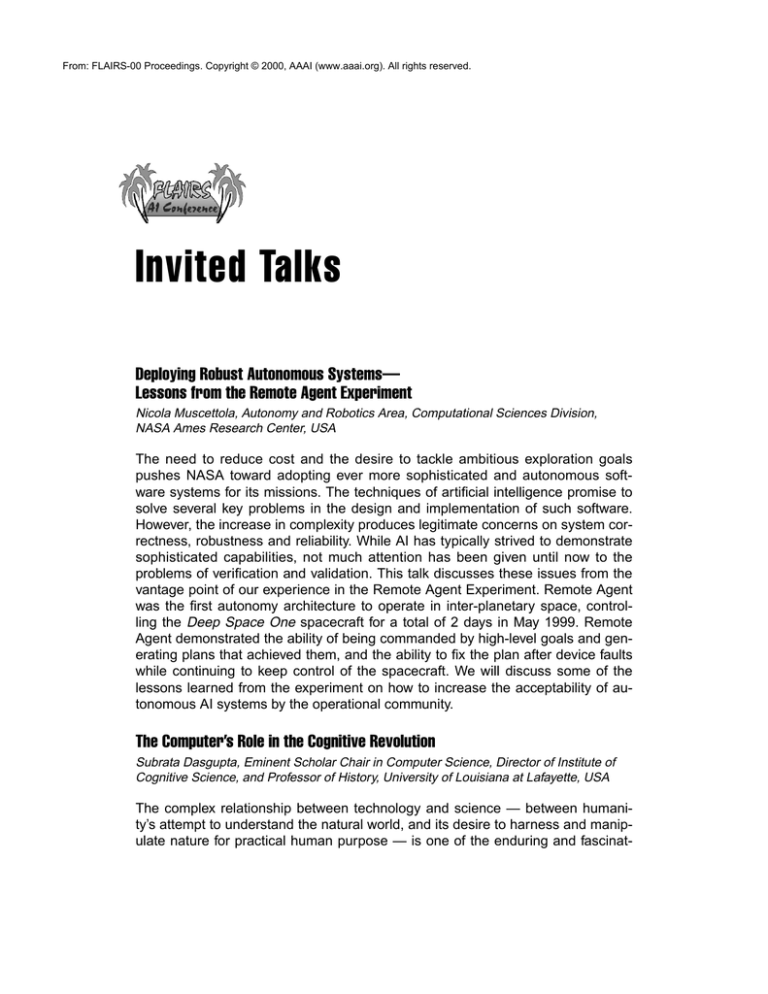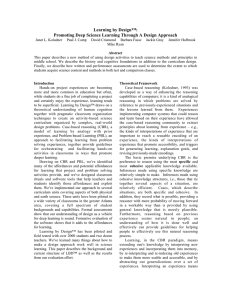
From: FLAIRS-00 Proceedings. Copyright © 2000, AAAI (www.aaai.org). All rights reserved.
Invited Talks
Deploying Robust Autonomous Systems—
Lessons from the Remote Agent Experiment
Nicola Muscettola, Autonomy and Robotics Area, Computational Sciences Division,
NASA Ames Research Center, USA
The need to reduce cost and the desire to tackle ambitious exploration goals
pushes NASA toward adopting ever more sophisticated and autonomous software systems for its missions. The techniques of artificial intelligence promise to
solve several key problems in the design and implementation of such software.
However, the increase in complexity produces legitimate concerns on system correctness, robustness and reliability. While AI has typically strived to demonstrate
sophisticated capabilities, not much attention has been given until now to the
problems of verification and validation. This talk discusses these issues from the
vantage point of our experience in the Remote Agent Experiment. Remote Agent
was the first autonomy architecture to operate in inter-planetary space, controlling the Deep Space One spacecraft for a total of 2 days in May 1999. Remote
Agent demonstrated the ability of being commanded by high-level goals and generating plans that achieved them, and the ability to fix the plan after device faults
while continuing to keep control of the spacecraft. We will discuss some of the
lessons learned from the experiment on how to increase the acceptability of autonomous AI systems by the operational community.
The Computer’s Role in the Cognitive Revolution
Subrata Dasgupta, Eminent Scholar Chair in Computer Science, Director of Institute of
Cognitive Science, and Professor of History, University of Louisiana at Lafayette, USA
The complex relationship between technology and science — between humanity’s attempt to understand the natural world, and its desire to harness and manipulate nature for practical human purpose — is one of the enduring and fascinat-
ing themes in the history of human culture. The appeal to technological artifacts
and their operations as a model or metaphor for the workings of nature is one
facet of this relationship. The use of technology to built physical instruments that
help perceive the natural world is another. Both uses serve a common purpose:
as amplifiers of the human ability to comprehend the natural world. My focus in
this talk is on a very recent technological artifact — the computer — and the role
it has played as an amplifier for comprehending one kind of natural phenomenon,
one we call mind. Using an historical perspective, I will review how the computer
has served to make and shape the scientific movement often called the cognitive
revolution. I will try to explain how the computer has served roles in effecting this
revolution, both as a powerful metaphor for explanation and description, and as a
physical instrument for amplifying our sensory and cognitive capabilities for following mental phenomena.
AI and the Web: The Next Generation
James Hendler, University of Maryland and DARPA/ISO, USA
It is clear to most Web watchers that the “next big thing” is a web in which far
more of the information is produced by and for machines. Instead of a web of information for human presentation, the web will enable new applications and environments enhanced by computational “agents” that perform many low level tasks,
freeing humans to use the web without many of today’s hardships and
headaches. The overwhelming amount of information available out there, however, makes this a daunting task and a challenge to the AI community: this is our
revolution to win! Unfortunately, accepting this challenge may completely revise
how we view the field of AI, and the methodologies we use. In this talk I look at
the web through an AI filter — what is the web, why is it hard for us, and how can
we take advantage of the opportunities it may offer if we accept the challenges. In
passing, I also point out that this may be the best thing ever to happen to AI —
freeing us from the rut we are in now to explore the really hard science of how
humans think and interact!
Promoting Transfer the Case-Based Reasoning Way
Janet L. Kolodner, Professor of Computing and Cognitive Science,
Georgia Institute of Technology, USA
Studies in cognitive science and cognitive psychology tell us much about the ins
and outs of promoting transfer — the ability to apply what one has learned in new
situations. They tell us just how hard it is to promote transfer, some conditions
that are better than others, some of the characteristics of learning environments
that promote transfer, and some exemplary classroom practices. Nonetheless,
those accounts are far from complete enough to use in designing classroom ac-
tivities that promote transfer, as they are weak in telling us exactly what’s going
on cognitively in the learner. Case-based reasoning, originally developed as a
way for computers to reason like experts, begins to address that issue by providing a model of the processes involved in integrating experiences into memory, retrieving them when needed, and applying them — the basic processes required
for good transfer. CBR’s model makes suggestions about the kinds of reasoning
that promote turning one’s experiences into easily-accessible cases, and the
kinds of interpretations and variety of experiences that promote extraction of and
iteration towards deep understanding of concepts and acquisition of skills. Understanding the implications of that model has allowed us to extract principles and
cycles of classroom activities that should promote transfer and an approach to
learning science called Learning by Design (LBD). We’ve implemented LBD’s
principles in a variety of curriculum units aimed at middle school students and in
software called SMILE. Evidence of transfer and of development of the kinds of
understanding that will allow later transfer is abundant.








